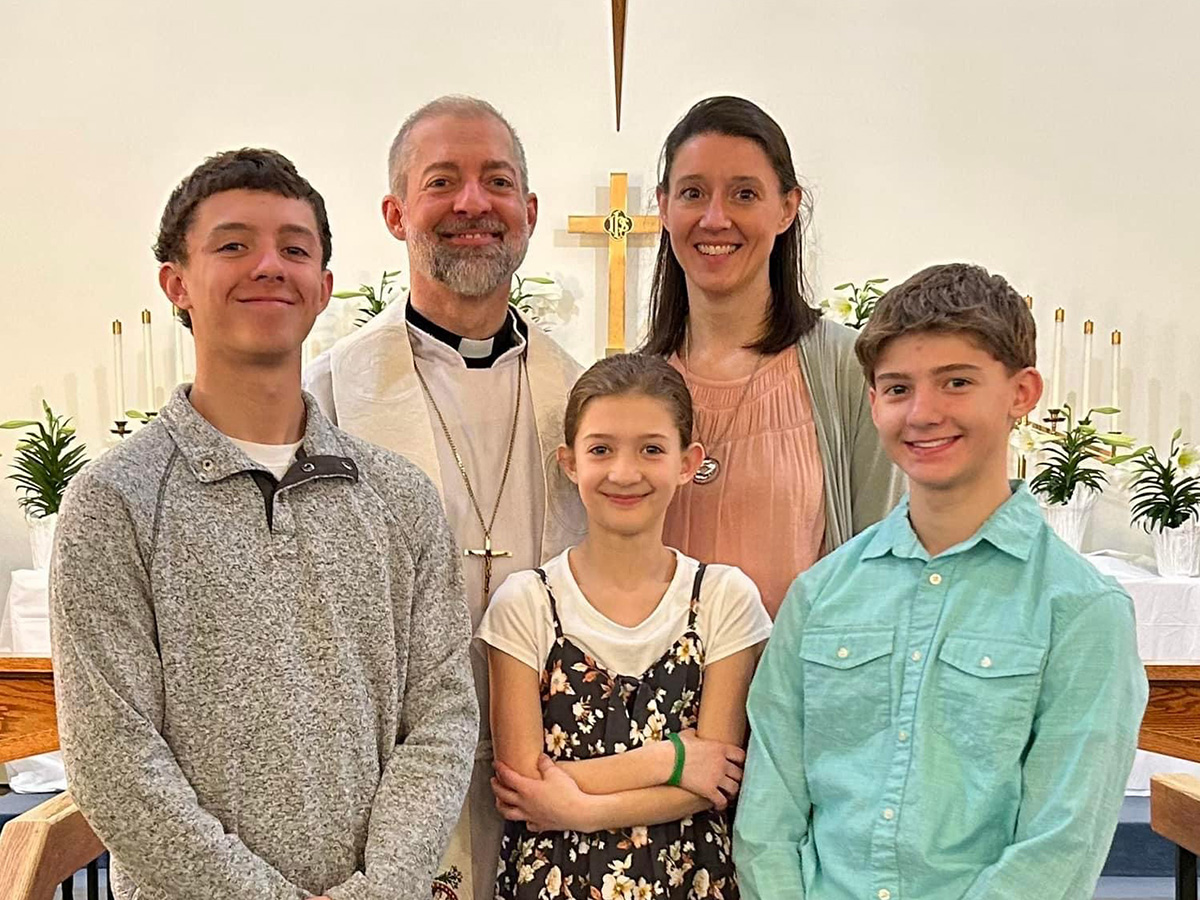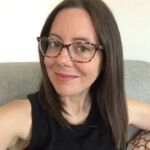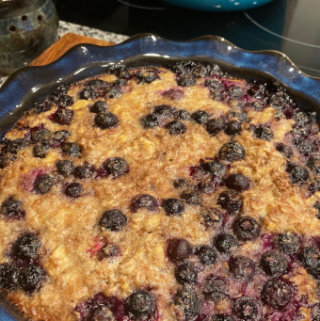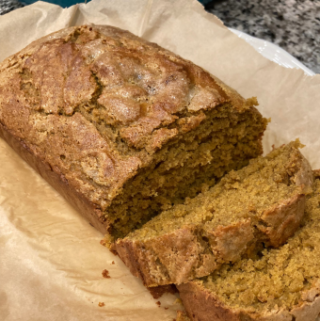
Since my family’s journey with toxic mold in our church parsonage, I’ve met over a dozen families in Lutheran ministry who have walked a similar path. I think it’s important for us to share our toxic mold stories. They bring awareness. They educate. Sometimes, our stories inform someone who may be living in toxic conditions. Our stories may be the reason that someone else reaches out for help. Our words, our shared experiences, are invaluable.
The first story that I shared was that of the Davis family from Arkansas. This time, we’ll hear from the Zellers family. Kevin and Erin Zellers currently reside in Iowa, but their story begins in Minnesota where Kevin served his first call as a Lutheran (LCMS) pastor. As I intend to do with all of the toxic mold stories I share, the Zellers’ story is written in first person. These are the words of Erin Zellers as she told their family’s story to me.
THE BEGINNING – HINDSIGHT IS 20/20

Our toxic mold story began a decade ago when my husband took his first call to Minnesota where we moved into a parsonage. I was newly pregnant with our third child. Pregnancy was a little harder – more nausea, more uncomfortable. I noticed discomfort with some foods I ate. I gained more weight and had more swelling. After our daughter was born, I never came out of the fatigue and loose ligaments. I had developed a lot of joint pain and struggled with depression. I found relief from most of the pain by cutting gluten out of my diet nearly a year later. (Interjection – This part of Erin’s story is nearly identical to my own beginning with mold toxicity.)
Over time, we had multiple sewage backups in the basement. We cleaned them up ourselves. We knew there was black mold on the basement walls and wondered if it could be attributing to my condition. A church trustee and my husband did DIY remediation all the wrong ways. They removed wood paneling without personal protective equipment and bleached everything. At the time, we didn’t know any better.
Meanwhile, I began to see conventional doctors, but found no answers. I had negative Lyme testing, negative mold (allergy) testing, negative everything. At the same time, our middle son had reoccurring strep. I don’t recall a lot of other specific issues. I suspect that we normalized just being sick.
A HOPEFUL MOVE
After living in the parsonage for six years, we finally convinced the church that the needs of the ninety year old house were greater than its value. Over the years, before our arrival, it had been somewhat neglected. The tenant of the house across the street happened to be considering a move about the same time. So, in the nature of small town affairs, the church purchased the home without a formal inspection and we eagerly moved in thinking that we were escaping mold issues. (If that was indeed the problem…we still weren’t sure.)
We were assured there were no water issues in the basement. We would soon find out that information was not accurate.
About a year later, we discovered terrible mold behind a refrigerator in the basement. We realized that water was coming (almost pouring in) from one side of the house. It took a lot of detective work, especially given our lack of knowledge. We discovered that the gutters were not working properly so rain water was dumping right along the foundation of the house and pouring into the basement. There was negative grading all along the house too – it basically sat in a valley.


CONNECTING THE DOTS
Over the course of the next year, I developed panic attacks. The frequency of other symptoms increased. I experienced gastrointestinal issues, brain fog, depression, dizziness, daily pain, ongoing fatigue, and developed issues with spatial awareness. Our middle son (probably the next most sensitive) had bouts of uncontrolled emotion/rage, anxiety, and insomnia. Our daughter, who I mentioned at the beginning of our story, developed 10-12 cavities out of nowhere. She had also begun to lose bladder control. She had headaches and stomach aches often. Our oldest child and my husband seemingly had very little reactions.
Finally caving to the need for depression meds and not finding answers to my myriad of symptoms, I did some genetic testing to determine the best options. That is where I uncovered my compound heterozygous MTHFR mutations (A1298C & C677T). This was the beginning of my turn toward answers within the naturopathic community.
A good friend, and fellow pastor’s wife, noted that this gene is common among others with chronic illness, so I began a deep dive into understanding the significance of MTHFR SNPs. This soon landed me in Facebook groups for MTHFR, Dr. Ben Lynch (a naturopathic epigeneticist), True Healing Strategies with Dr. Jaban (who healed himself from Lyme at a young age), and a whole community of folks looking for answers regarding chronic illness. This process led my attention to mold toxicity.
As I began to connect the dots, we had the mold in the second parsonage removed. It was still not properly remediated as I hadn’t climbed that learning curve yet. I continued researching as much as I could being neurologically compromised. I would then share knowledge with my husband.
AN UNEXPECTED TURN OF EVENTS
In the fall of 2020, my Dad came up to help us attempt more DIY remediation in the parsonage basement. He worked with my husband to tear down some old, damaged shelving. Sadly, my Dad died in a car crash on the way home – seemingly suspected to have fallen asleep at the wheel.
After my dad passed away, we decided that we were done trying to DIY. I had found a mold literate naturopath earlier that summer. From her, I got the name of a legit mold remediation company. We asked the church to cover the expenses.

MOLD TESTING
Over time, I continued to work with the naturopath, but I was still struggling. At one point, I hit a plateau. We ran an ERMI (Environmental Relative Moldiness Index) and found high levels of aspergillus and a small amount of stachybotrys in the house. That was the first time we’d actually done any mold testing, and part of me wonders if maybe the stachybotrys was left over from the mold behind the fridge, but we may never know. The church paid for yet another remediation.
Meanwhile, I was doing all the things (eating clean, doing sauna, castor oil packs, dry brushing, daily walks, red light therapy, anti-fungals, anti-parasitics, and I was taking all the supplements – milk thistle, a broad spectrum binder, B complex, vitamin A/D/K, magnesium glycinate, NAC, lipotropic detox, fish oil, trace minerals, and probiotics). All of that and I could not kick the fatigue and depression.
We ran mycotoxin antibody testing on me and my levels came back with vomitoxin off the charts, as well as a few other offenders. I learned that vomitoxin isn’t even produced from mold growth on building materials, but from growth on grains. Right in the middle of our little town sat a turkey feed mill. The first ingredient in turkey feed is grains. I tried to reach out to public health officials, but received no relevant response. There was nothing I could do about that potential exposure.
THE FINANCIAL BURDEN OF MOLD TOXICITY
It’s SO expensive to attempt recovery from mold toxicity. We’ve spent thousands of dollars on my treatment, health coaching, and on testing. Ironically, the only reason we can afford ANY of it is because of the money we received at my Dad’s passing. It’s funny how God works.
When God opened a door for us to move to a new home in a new town, we had to consider what to do with our contents. In the beginning, I thought the idea of purging everything was ridiculously over dramatic. But I’d been sick for so long. I was desperate to heal. Fortunately, I never held a lot of sentimental value in things anyway. On the other hand, I also had a husband and three children, and all their needs and emotions to consider. For the most part, the mold seemed to have only isolated impacts on them. It was not gravely impacting their daily life in the way it was mine, yet they were asked to make numerous sacrifices to enable me to heal.
In order for us all to come to terms with these sacrifices, we needed to understand what none of us could see…that the contaminants which had been keeping me sick were invisible, that the nature of airflow enabled them to travel through the entire house, and that the contaminants could spread and stick as easily and broadly as glitter. This understanding and emotional evaluation required time and numerous discussions.
As much as I wanted to compromise for the sake of my family’s emotional well-being, I also didn’t want to pass up this long-awaited opportunity for a new, clean environment; an opportunity that would FINALLY enable me to heal. I’d spent the past two years researching, and the past ten years suffering and searching for answers.


THE ZELLER’S REASON FOR SHARING
When communicating with Erin by email, I asked her WHY she cared to share this story publicly. This was her response:
That’s a great question (the why). Ultimately it’s absolutely to spread awareness, but I go back and forth about how to be impactful…specifically to families and congregations in the pastoral ministry.
I think because our moldy house was a parsonage, it felt natural to blame the church. (As humans, we just want someone to blame right?) There was obviously neglect so it seemed easy to do. But I keep coming back to how many times we did things wrong because we just didn’t know any better. As we attempted to bring trustees and parishioners onboard with our needs, they were receptive to a point. I think the real issue is awareness, but due to the nature of dependence on the church as a non profit organization run by committees and supported by volunteers…it’s just a recipe for the perfect storm. In a church setting, this is compounded by the lack of awareness, and a lack of finances in many cases.
Ultimately, this could have easily happened to us NOT in a parsonage. We learned that DIY is not appropriate when it comes to mold remediation. We also learned that it’s hard for people to realize the impacts of modern civilization on America’s declining state of health.
Attempts at remediation and healing feel like trying to run through peanut butter. Ultimately, I want to be available for support. This can be a hard, lonely, isolating and difficult-to-navigate journey. I really wish I had more support during our journey. I think our story can offer that support and awareness to others.






Leave a Reply
You must be logged in to post a comment.